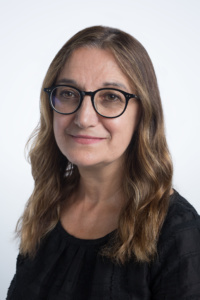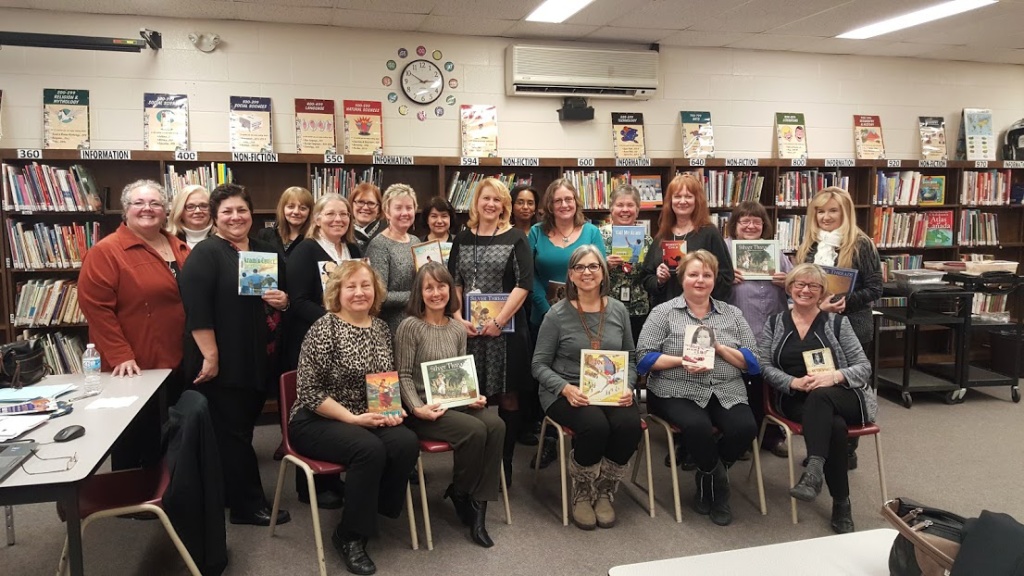
Can you tell me about Tinlids? / What should authors and illustrators know about Tinlids?
Tinlids is a Canadian book wholesaler that sells to schools and public libraries across Canada. We are the official wholesaler for the Ontario Library Association Forest of Reading program. In addition to our website (tinlids.ca) and other online presence (facebook, twitter, instagram), we also have a 5,500 sq ft showroom in north Toronto, that anyone can shop in from Monday-Friday. We purchase books from all major and many smaller publishers. We are also a strong supporter of Canadian authors, illustrators and publishers. We make good coffee.
What is your role at Tinlids? My main role is to make good coffee. I also help teachers and librarians with their selections, and make sure we’re carrying the very best books for our customers. I do all of the buying for our showroom and for special school board events. I also provide lots of booktalks and selection help on a daily basis.
What did you do before Tinlids? I worried less, worked shorter hours, had time for parties… I could go on. Okay, I was a social worker, working with children, adolescents and teenage moms. I really loved working with kids, but after eight years I decided I needed a change. One day while I was walking around Toronto and thinking about what I wanted to do next, I discovered The Children’s Book Store. I applied for a job and was hired the next day. It was a dream job. I ended up staying there for 17 years. When the owners (Judy and Hy Sarick) retired, they sold the educational division to Pegasus, which was a huge distribution centre, owned by Chapters. I was the Children’s Collection Development manager there. Pegasus closed after a year, and then I worked for another wholesaler for a couple of years. Two years later, in 2003 I started Tinlids.
Can you describe your typical day?
Contrary to what some might think, I don’t read all day! But I do read every night. A typical day often starts out with a morning meeting with either a customer who is shopping in our showroom, or a publisher rep who is selling me the next season’s titles. Whether I am purchasing for Tinlids, or helping a customer, that can take up most of my day. Sometimes my purchasing meetings last for 4 hours, and I can have 3 or 4 full days of buying in a week. If it’s “show season”, I will be out of the office selling at various school board events, or doing booktalks.
I usually have tons of email and lots of selection to do for customers. Often a customer will give me a budget and ask me to select books for them based on some specific needs. So most of my day is spent thinking about books, buying books for our showroom, selecting books for libraries, or making lists I especially love helping customers start their collection for a new library. It’s great to see new books, but I really love those backlist titles that are still strong core titles for libraries. There are hundreds of gems in the backlist.
What drives you nuts? The declining number of teacher-librarians in the schools. Customers who tell me they don’t want to buy books for their intermediate students because those students don’t read. Scaredy-cat librarians who worry about books that might have a “swear word” in them.
What are you grateful for? Authors and Illustrators who are brave enough to write about sensitive topics that kids want to know about. Publishers who are brave enough to publish those books. Teachers and librarians who are brave enough to buy them. I’m grateful that there are now many more Canadian authors and illustrators than when I started bookselling. And I love the diversity in our Canadian books. I hope it continues to grow.
What is your selection criteria for books? When I’m choosing fiction, especially YA fiction, I need to believe the characters and care about them. They need to have an authentic voice. I don’t like preachy fiction or books with an obvious message that hits you over the head. I love when an author really captures the realities of being a teenager. Authors like Susin Nielsen, Teresa Toten and Martine Leavitt do this well. Remember what you went through as a teen? Or what you wished you had gone through? All the bad choices you made? All the thoughts you had? Thinking about your future, drinking, sex, drugs, the world and how you do or don’t fit into it? I get anxious just thinking about it. I love when authors remember and are true to the crazy messed-up teenage psyche. Those are the brave authors.
Picture books are easier to buy of course, but I still say no to many titles that just aren’t good enough. I choose picture books where the illustrations and text work well together. That might sound simple but it’s not. I like when the illustration tells you a bit more about the character, and when the text is so great that you don’t even need the illustrations. I love books that are great read alouds – again, sounds simple but it’s not. I also love wordless picture books and “advanced” picture books. Advanced picture books are great for junior, intermediate or high school students, and usually provide great starting points for discussion or further exploration of an important subject.
Okay I could go on for hours about this. Don’t get me started on poetry (love it and want more of it), graphic novels (love) and non-fiction (love but pickier about non-fiction). I seriously want to keep talking but if I do, this will end up being a book instead of an interview.
The books I choose have to fit into what I believe our customers want. They have to work for a classroom or library. I want books that will engage our modern students. That doesn’t mean I only want new books. It means I only want fantastic books.
What advice do you have for a first time author or illustrator? If it’s a published author or illustrator, find out which stores or wholesalers are supporting you. If you have a website, mention these stores as a place to purchase. Independent stores and wholesalers that hand-sell your book need your support too. Find out what your bookseller likes about your book. Go see them and ask questions. Be open to honest and constructive feedback. I always say “If you want my honest opinion, you need to be ready to hear that your baby is ugly.” See what your competition is. If you’re writing a picture book about a little girl who is attached to her bunny, it better be as good as (or better than) Knuffle Bunny by Mo Willems! If I bought every book with a bunny in it, I would need to open up a separate store. And call a good shrink… ack! so many bunny books.
What do you see as the future for the book business?
I think booklovers will always need curated lists and a place that showcases them. Sometimes you don’t know you want a book until you see it in a store or a library. I’ve been around long enough to see many different new technologies challenge the physical book and bookstore. I think we will always have people who want that experience of walking into a bookstore or library and being in that social space. I hope that the future will include more diversity from voices we don’t hear from enough.
What I DON’T see is only a digital future in the book industry. Apparently neither does Amazon, since it opened up a bricks and mortar bookstore last year.


 Is there an author or illustrator in Canada who doesn’t wait with bated breath for the annual Forest of Reading® shortlists to be announced? A Forest of Reading® nomination can make a book an instant bestseller and can transform a children’s author into something like a rock star.
Is there an author or illustrator in Canada who doesn’t wait with bated breath for the annual Forest of Reading® shortlists to be announced? A Forest of Reading® nomination can make a book an instant bestseller and can transform a children’s author into something like a rock star. 
 Stone, land on their list. Red Stone is based on the author’s own family‘s experiences in the 1930s Soviet Union when they’re exiled to Siberia as “enemies of the people”. This is an era that is puzzlingly off the radar for most publishers despite the fact that millions of Canadians have ancestors who escaped to Canada during Stalinist times.
Stone, land on their list. Red Stone is based on the author’s own family‘s experiences in the 1930s Soviet Union when they’re exiled to Siberia as “enemies of the people”. This is an era that is puzzlingly off the radar for most publishers despite the fact that millions of Canadians have ancestors who escaped to Canada during Stalinist times.



